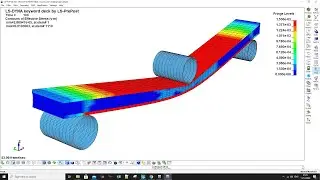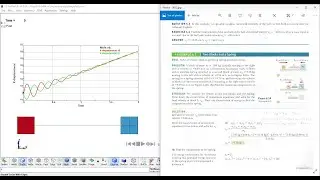LS-DYNA TUTORIAL 13: Reinforced Concrete and Wrecking Ball
I’ve been requested by many from Civil Engineering background to do a tutorial. So here it goes. I must highlight that I am actually from Mechanical Engineering, so if I said some of the terms wrong, or some of the values doesn’t make sense, feel free to laugh at me. But after you do so, please correct me in the comments!
In this tutorial, a reinforced concrete slab is subjected impact by wrecking ball. The wrecking ball is dropped from a horizontal position (I know this is not practical, but this tutorial is only for learning purposes). The concrete is reinforced with steel bars, modelled as beam elements. The interaction between reinforcement and the concrete is modelling with CONSTRAINED_LAGRANGE_IN_SOLID coupling.
Two material models for the concrete were used in this video, first, MAT159_CSCM_CONCRETE and then MAT084/85_WINFRITH_CONCRETE. The former has the option of defining the plastic strain if element erosion is required. This material model is a good option when modelling concretes subjected to high intensity loads such as blasts. While the second material model doesn’t have this option of element erosion, it got a unique capability which allows to visualize the crack using DATABASE_D3CRACK. The time interval should be EQUAL to that in D3PLOT. Note that you must type in the command line “q = d3crack” or else the files while not be printed out and you will be disappointed.
Let’s get back to the wrecking ball, in this video, I showed how to simply create a solid hollow sphere. Why would you do that? Maybe you need a very super fine mesh for the ball curvature but you need to save some memory (by reducing the file size). Of course, you can just use shell sphere, but where is the fun in that, right? Bonus: I also shared how to make the mass equal to that of a solid not-hollow ball. You just need to increase the density by the right factor. Of course, you can do like what other do and just add mass element. But then you need to create a node at the centre of the sphere and then link it to the hollow sphere. So, for me, that’s a hassle.
Last but not least, how to use DEFORMABLE_TO_RIGID and variable time intervals, the former is to reduce the run time and the latter is to reduce the results size. Here, I shared only the basics of deformable to rigid. You may practice by your own to get your hand on the other switching “CODE”s. It is a life saver as I shared in my previous video, here
• Rollover Analysis of Pickup Truck
In summary, this video covers:
• How to model concrete with MAT159 and MAT084/85
• How to model reinforcement bars with beam elements
• How to create beam elements (two different methods)
• How to define gravity load
• How to define variable d3plot time intervals
• How to simple make a solid hollow sphere
• How to view the damage/cracks with the above material models
• How to use deformable to rigid keyword (basics only)



















